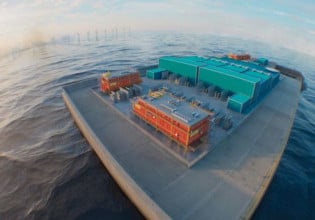Near Industrial-Scale Pilot Line for Organic Solar Cells Developed by Fraunhofer IAP
Organic solar cells and light emitting diodes (OLEDs) can now be developed at Fraunhofer Institute for Applied Polymer Research (Fraunhofer IAP) in Potsdam-Golm in a near-industrial scale. The new pilot line was designed and implemented by Fraunhofer IAP in cooperation with the plant manufacturer MBRAUN. The plant was commissioned on January 15th and 16th, 2013, as part of a trade event for organic electronics.
Until now, the researchers developed the components only on a laboratory scale. OLEDs and organic solar cells are used not only in architecture. For designers or applications in textile and life sciences industry, they are very interesting, as well — especially due to the possibility to make flexible devices.
"We are proud that we successfully constructed the pilot line in close collaboration with Fraunhofer IAP. Thus, optimal conditions for cutting-edge research have emerged at the research site Potsdam-Golm," said Dr. Martin Reinelt, CEO of MBRAUN. "We hope to strengthen the German research landscape in order to compete successfully with American and Asian research institutions. We also want to demonstrate the performance of German plant manufacturing."
At the two-day event, the partners present the new pilot line, its potentials and current research topics of Fraunhofer IAP in the field of organic electronics. Subsequently, the visitors can gain an insight of the plant on site. In workshops, renowned experts speak about recent trends and developments in organic electronics — including material developments, technologies and applications. About 70 participants are expected. The pilot line is part of the recently opened Application Centre for Innovative Polymer Technologies of Fraunhofer IAP which is directed by Prof. Dr. Hans-Peter Fink.
A demonstration of the new technologies was developed using a 1:20 model bus shelter that has a height of only ten centimeters. Energy efficient OLEDs display the schedule or give light signals when a bus arrives. Their energy comes solely from the sun: In the roof and the side wall organic solar cells are integrated, which are partially transparent. It was designed by the Potsdam office for product design fdesign within a joint project with Fraunhofer IAP, funded by the Federal Ministry of Research. The Potsdam Fraunhofer Institute developed the OLEDs as well as the organic solar cells.
"The model shows that organic electronics has great design potential for energy-saving, intelligent lighting control and information systems. To apply these technologies to life-size street furniture, the new pilot line now offers the possibility to realize organic electronic components under near-industrial conditions - a crucial prerequisite for the later transfer into commercial products," explains Dr. Armin Wedel, Division Director at Fraunhofer IAP.






